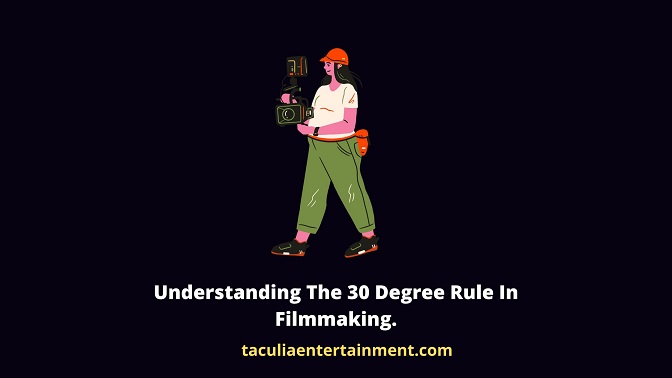
There are basic rules in filmmaking that filmmakers are expected to consider or follow, and you might have come across most of these rules such as the rules of thirds, 180 degree rule, 30 degree rule etc.
While these rules are not strict or a must to follow, following them will enable you to achieve the industry standard of filming because majority, if not all the films you are going to see out there were made adhering to these rules.
Now the main rule in filmmaking we are going to treat in this article is the 30 degree rule, and our aim will be t to discover the meaning of the 30 degree rule, why we should follow it as well as the ways you can break this rule.
So without any further ado, let’s get started.
What is 30 degree rule in filmmaking?
The 30 degree rule states that a camera should not exceed 30 degrees when it is moving between shots.
This rule was given to help avoid a jump cut which happens when two shots are cut together while the camera remains in the same position and it makes the the subject who is moving in the second shot appear to be moving forward.
This type of cut usually jars the audience and make them easily notice the technical side of filmmaking instead of focusing on the story.
When you use the 30 degree rule to calculate the movie shots you will realize that it will not be no more than 180 degrees total.
As a matter of fact, using the 30-degree rule will help the continuity of filmmaking flow harmoniously from one scene to another even when a lot of shots are taken in sequence.
How to use the 30 degree rule in filmmaking.
To use a 30 degree rule in filmmaking, you can begin a scene with a close up shot that changes to a wide shot to reveal every details that is prevalent in the scene.
By doing this, you will be able to eliminate or cover up any minor continuity error that might have been prevalent in the scene.
Why should we follow the 30 degree rule in filmmaking?
The main reason we should follow the 30 degree rule in filmmaking is to avoid a jump cut or any continuity mistake that is prevalent in a movie scene.
Another reason we should follow the 30 degree rule is to help editors find a perfectly matching moment when they are cutting and assembling different shots and angles that were taken for a particular scene and build a perfect continuity without showing the actors error or fault in any of the shots.
It is a fact that no actor, no matter how professional they might seem to be, will be able to perform or repeat every single action he took when the cinematographer is taking multiple shots and angles.
For example, if the actor was wiping his face with an handkerchief while maintaining the same dialogue in a close up shot and fails to do so during the wide shot, the 30 degree rule will help the editor to avoid mixing both shots while editing the particular scene.
How the 30-degree Rule helps in visual storytelling.
The 30 degree rule plays a vital role in visual storytelling by helping the cinematographer and editor facilitate smooth shot transitions while maintaining coherence in space.
Below are some of the ways the 30 degree rule can help in visual storytelling:
1. Space and location orientation.
By adhering to the 30 degree rule in filmmaking, filmmakers will be able to establish a sense of space in every location of the scenes they are shooting.
As the camera moves from one point or angle to another, the audience will be able to perceive the relationships between subjects and their environment, and in the end this will enhance the overall understanding of the whole story from scene to scene.
2. Visual interest.
The 30 degree rule also helps filmmakers to vary their camera angles and perspectives and in so doing add some visual interest to their storytelling.
When you shift the camera from one position to another, you will be able to introduce viewpoints, depths compositions etc. and in the end provide a fresh visual experience for your audience.
Personally, I love to film a lot of camera angles and shots, as well as move my camera enough to help me make each shot more appealing and interesting, so that when I an editing the footages in post-production I will have enough shots to cut between and avoid any continuity error or jump cut that might have sneaked into any of the shots.
How do you break the 30 degree rule?
Strategically, you can break the 30 degree rule if you are aiming to highlight significant moments or any key element in the story. Tis violation of the 30 degree rule will therefore draw the viewers’ attention to a particular subject which you want to create an impact within the narrative.